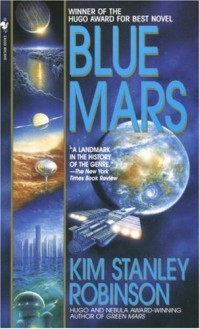
This last book of the Mars trilogy is the most epic in scope, covering some one hundred years worth of events and extending the saga to the rest of the Solar system and even beyond. At the same time, it feels frustratingly parochial, with its strong focus on the same old set of characters who are forced to deal with new iterations of familiar problems. As much as we readers have grown to love these characters over the course of the previous books, it’s hard to shake off the feeling that this book isn’t just a retread of what has come before with added proviso that many of the characters are now so mature as to leave little room for additional character development.
The book picks up right where Green Mars ended, with the final days of the successful Martian Second Revolution. This time, thanks to extensive preparations by Sax Russell’s Da Vinci group as well as massive floods on Earth due to the collapse of the Antarctic ice cap, the revolution is successful. What’s interesting is that with victory against Earth and its metanats all but certain, the central conflict is between the Reds who want nothing to do with Earth and the Greens who believe that Mars’ long term security lies in cooperating with Earth as a partner of equal status.
This directly leads to some of my favourite chapters of the book detailing how Art helps Nadia to set up Mars’ first government and the Martians’ visit to Earth. Of particular delight is Nirgal admiring the hugeness and primal beauty of the mother planet and how Earth can be even more Martian than Mars itself. Also satisfying is the long awaited return of Michel to Provence who finds himself both disappointed in how much it has changed and how little is left of what he remembers and yet in the end remains convinced that Provence is his home.
After this, the narrative becomes less coherent, feeling more like a collection of short stories than a novel. Some are of dubious interest such as Nirgal trying to find a place for himself in a free Mars by trying to be what is here called an ecopoet but seems to amount to being a farmer. By contrast Nirgal’s training for the Round-the-Worlder Martian marathon and his stint with the ferals is fun to read, but feels like a ham-handed attempt to convince readers of the authenticity and the rich variety of lifestyles on Mars.
I did like the scenes of humanity spreading across the rest of the solar system and attempting to terraform such hostile environments as the surface of Mercury and the moons of Uranus. They also serve to highlight the new character of Zo, Jackie Boone’s daughter, who has nothing but complete disdain for Earth and the First Hundred and chooses to live life seemingly for pure sensory pleasure. She also has an intriguing scene with Sax Russell, which is great inasmuch as it reveals more about these two characters, but once again doesn’t really seem to gel together as part of a novel.
The last few chapters deal with the decline and deaths of many of the First Hundred and the increasingly serious memory problems of the few left who survive. These bring much needed closure for these key characters but there’s also an element of fanservice here since these scenes are removed from the story of Mars as a whole. It’s especially galling that the backdrop here is increased illegal immigration from Earth, reinforcing the sense that these are all things that we’re read before, over and over again.
Reading this, I became very irked at how blatantly Sax Russell is the author’s favourite character. Russell was my own favourite character when I first read this trilogy as well but after this reread, I find it impossible to buy how he is able to constantly reinvent himself as a scientist in order to solve the latest problem of the day. And to top it off, Kim Stanley Robinson is unable to resist making him the one character to have what is unambiguously a happy ending.
This is, of course, just a stronger version of the problem I previously pointed out: Robinson only wants to write the POVs of the characters whose views are essentially his own. There is no attempt for example to explain the motivations of characters like Jackie who are used as villains. Why does Jackie think that antagonizing Earth will benefit Mars? Or is it that she is still willing to sacrifice Mars’ long term future for short term political power? We don’t know. It is equally frustrating how the post-Praxis metanats can go back to making their usual trouble behind the scenes, as if nothing had changed at all. We don’t know anything about this because William Fort doesn’t appear in this novel at all.
Robinson is still a good enough writer that just reading this as a coda for the characters we have come to know so well is satisfying. We can’t help but be moved by the final fates of Maya, Michel, Ann and all the rest. But this can’t hide the sense that he has run out of ideas for this series. The conflicts, themes, personalities etc. are exactly the same ones we’ve seen before.
Taken as a whole, it’s evident to me now that the very first book is the best of the trilogy, mostly because of the very detailed, step-by-step account of how Mars can be colonized. The rest is above average writing and filled with interesting insights on human psyche, but there too many flaws for the series to make any claims towards being great literature. I am sad to conclude my rereading of the books has diminished my opinion of their quality. I suppose it really was rose-tinted glasses all along.